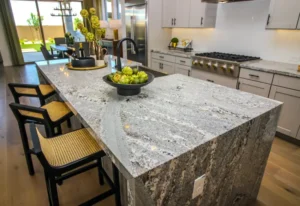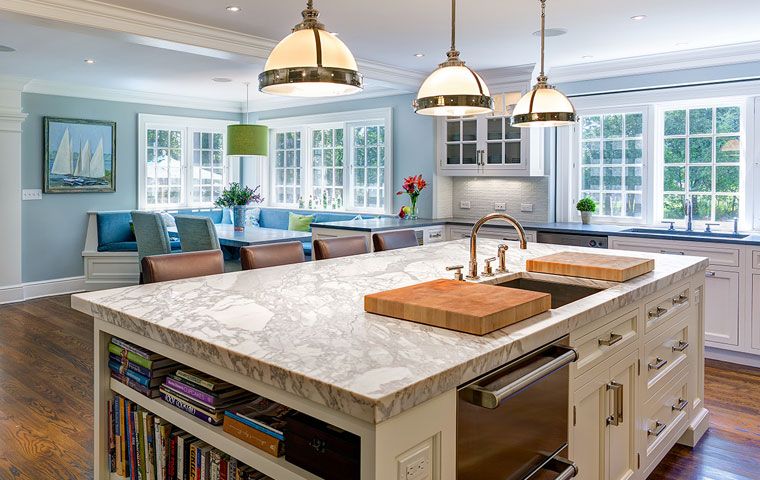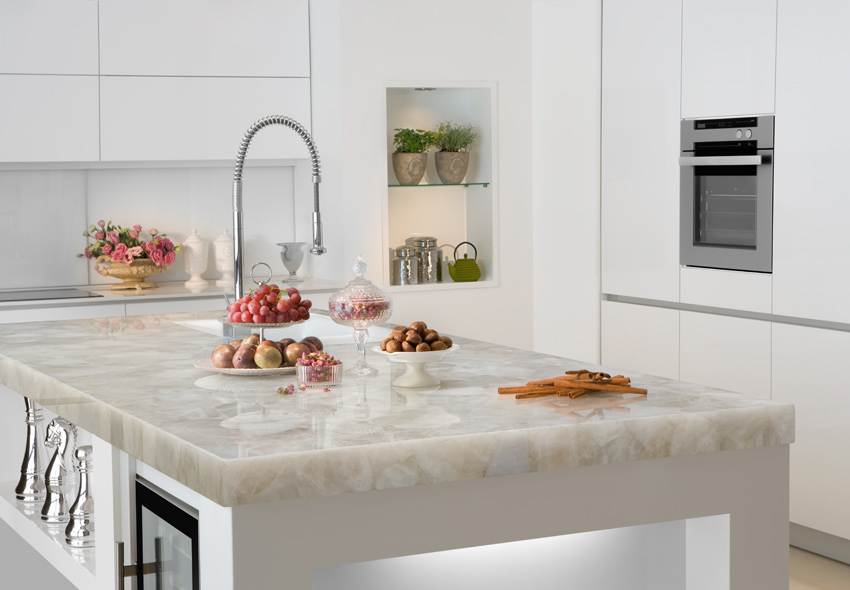Quartz countertops rank among the toughest work surfaces on the market, yet many homeowners still wonder: “Are quartz countertops heat resistant enough for daily cooking?” The short answer is yes—within limits. Quartz can tolerate typical kitchen temperatures, but exposing it to direct, intense heat can leave permanent marks. This comprehensive guide (≈1,500 words) explains how quartz behaves under heat, compares it with other countertop materials, and shares field-tested ways to prevent and repair thermal damage.
How Heat-Resistant Is Quartz?
| Test Scenario | Temperature | Result on Quartz |
| Warm serving dish | 120 °C / 248 °F | No visible change |
| Freshly boiled kettle base | 150 °C / 302 °F | Usually safe for ≤ 2 minutes |
| Cast-iron pan straight from the oven | 205 °C / 400 °F | Potential resin discoloration |
| Red-hot pan off a gas stove | 260 °C / 500 °F | Likely burn ring, cracking, or dull spot |
Most manufacturers rate quartz for short bursts up to 150 °C. Anything hotter should be placed on a trivet to avoid breaching that safety margin.
Quartz vs. Granite, Marble, and Laminate
| Countertop Type | Heat Tolerance | Notes |
| Quartz | Good to 150 °C | Resin layer is the weak link |
| Granite | Excellent > 260 °C | May survive direct burner contact but can fracture if moisture is trapped |
| Marble | Moderate 180 °C | Prone to thermal shock and etching |
| Solid-surface (acrylic) | Poor 100–120 °C | Easily scorches, warps, and blisters |
| Laminate | Low 80–100 °C | Adhesive detaches, top layer bubbles |
Quartz strikes a balance: tougher than laminate or acrylic, but still more vulnerable than most natural stones.
4. Everyday Kitchen Heat Sources
- Stovetop pans—cast iron retains heat longer than stainless steel.
- Oven trays—baking sheets can exceed 200 °C.
- Small appliances—air fryers, portable griddles, and waffle makers vent hot air sideways.
- Crockpots & Instant Pots—slow-cooking units radiate gentle warmth for hours.
- Direct sunlight—south-facing windows may push surface temps toward 60 °C during summer; still below resin failure, but daily exposure accelerates fading.
5. Five Proven Ways to Protect Quartz from Heat
Use Trivets and Hot Pads
Always place hot cookware on a wooden, cork, or silicone trivet. Metal trivets conduct heat, while silicone pads grip better and insulate more effectively.
Set Drinks on Coasters
Double-wall mugs reduce the risk, but a simple coaster prevents ring stains from heat plus condensate.
Choose High-Quality Quartz Brands
Not all slabs are equal. Top-tier manufacturers use resins with higher heat deflection temperatures and perform rigorous lab tests for UV stability. Ask for documentation before you buy.
Shield Surfaces from Direct Sunlight
Install UV-filtering window film or use pull-down shades in sun-drenched kitchens. Prolonged ultraviolet exposure accelerates yellowing of lighter quartz tones and darkening of black slabs.
Prevent Rapid Temperature Swings
Thermal shock can occur if you pour ice water onto a section still hot from the roasting pan you just moved. Allow surfaces to return to room temperature naturally.
6. What Your Warranty Says About Heat Damage
Nearly every quartz warranty excludes “thermal abuse.” That means:
- Placing cookware hotter than 150 °C on the surface voids coverage.
- Damage from fireplaces, outdoor grills, or radiant heaters is on the homeowner.
- Sunlight-induced fading may or may not be covered—read the fine print.
Documenting installation photos and keeping receipts helps if you ever need to submit a claim.
7. Signs of Heat Stress and Discoloration
- White haze or cloudy ring where the skillet sat.
- Shiny patch turned dull; resin may have burned away.
- Amber or brown stain on lighter quartz colors.
- Hairline cracks radiating from the burn spot.
- Raised bump—resin expanded then cooled unevenly.
Addressing small marks early prevents moisture intrusion and deeper staining.
8. How to Fix Heat Damage on Quartz
Minor Surface Haze
- Clean with isopropyl alcohol.
- Wet-sand gently with 600-grit paper.
- Buff with quartz polish until the sheen blends.
Discoloration or Burn Ring
- Lightly sand starting at 400 grit, feathering outward.
- Move to 800 grit, then 1,000 grit for high-gloss finishes.
- Apply a stone-safe polishing compound.
- If color shift remains, an expert may tint a clear resin overlay.
Deep Cracks or Blisters
- Contact a certified stone technician. They use industrial-grade UV resins and polishing pads that restore surface uniformity better than consumer kits.
9. Frequently Asked Questions
Q: Can I safely use a countertop pizza oven on quartz?
A: Yes, if it stands on insulated feet or a thick trivet that keeps radiant heat from exceeding 60 °C at the slab surface.
Q: Does quartz discolor from hot hair-styling tools in a bathroom?
A: Most flat irons max out near 230 °C—too hot for direct contact. Use a heat-resistant sleeve or mat.
Q: Could a pressure cooker harm quartz?
A: Steam vents upward, but the metal base stays near boiling-water temperature. Allow a two-inch air gap or place the cooker on a wooden board.
Q: Is outdoor quartz an option near a grill island?
A: Only if the slab is specifically rated for exterior use and far enough from direct flame. Standard indoor quartz fades and weakens outside.
10. Key Takeaways
- Quartz offers moderate heat resistance—up to about 150 °C for short periods.
- Exceeding that limit scorches the resin, resulting in rings, haze, or cracks that are difficult to erase completely.
- Prevent damage with trivets, coasters, and UV protection.
- Most warranties exclude thermal abuse, so caution now saves costly repairs later.
- Small burns can be polished out; extensive damage calls for professional restoration.
Keep these guidelines in mind, and your quartz countertop will continue to dazzle guests without fear of heat-related mishaps.


